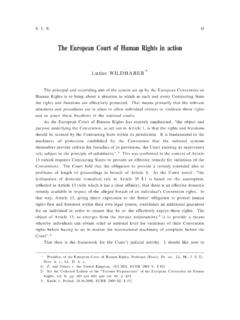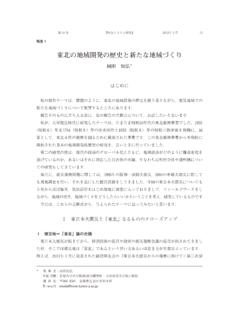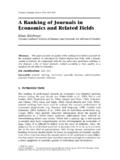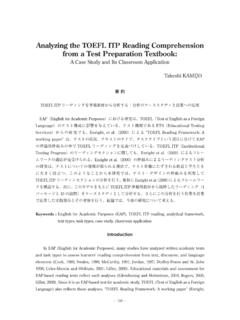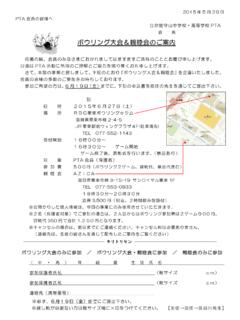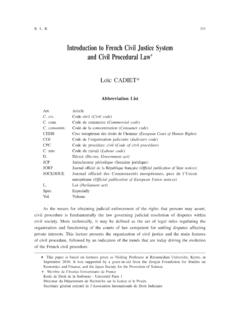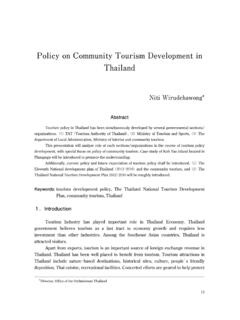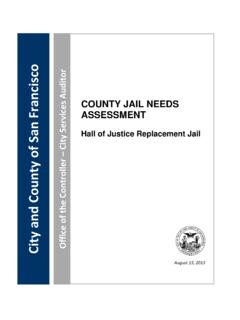Transcription of Managerial Accounting - 立命館大学
1 Managerial Accounting2011 First semesterTakayuki AsadaLecturerWe try to explain the contents from chapter 1 through 11 of this text book written by James Jiambalvo Managerial Accounting ,Third Edt.,John wiley & Sons,Inc.,2007)After such presentations by teacher and your assigned problems or exercises must be explained by yourself. I expect all of audiences to take part into this discussions. Lecturing schedule1) April 12 ,Chapter 1 Introduction to Management and Cost Accounting in the Information Age2) April 19,Chapter 2: Job-order costing for manufacturing and service companies3) April 26 Chapter 3:Process Costing4) May 10 ,Chapter 4: Cost-Volume-Profit Analysis5) May 17,Chapter 5: Variable costing , Inventory evaluation6) May 24, Chapter 6 Activity based Costing, Cost allocation7) June 7,Chapter 6-1 Activity based management8) June 14, Chapter 7: The use of cost information in Management 19) June 18(Saturday), Chapter 7-2 The use of cost information in Management 110) June 21 ,Chapter 8 Pricing decision.
2 Analysing customer profitability and activity based pricing11) June 28, Chapter 10-1 Budgetary planning and Control 112) July 5, Chapter 10-2 Budgetary Planning and Control 213) June 9(Saturday),Chapter 1114) July 12,Chapter 12 Decentralization and performance evaluation 115) July 19,Chapter 12-2 Decentralization and performance evaluation 2 Works for You in this classEvaluation of everyday performance inclass: you must answer each assigned problems at theend of each chapter(all of questions and some exercises or a case) at each next week class and check the frequency of your attendance. (20%)We do a written test at the end of semester. (80%)Evaluations1)Solution or results of each assigned questions and excercises(10%).2)The number of your attendances into this class(20%).
3 3)The score of final examination (70%).Chapter oneThis chapter s learning objectivesYou will be able to:1)State the primary goal of Managerial )Describe how budgets are used in )Describe how performance reports are used in the control )Distinguish between financial and Managerial )Define cost terms used in planning,control,anddecision )Explain the two keys ideas in Managerial accounting7)Discuss the impact of information technology on competition ,business processes,and the interactions companies have with suppliers and customers8)Describe a framework for ethical decision )Discuss the duties of the controller, the treasurer, the chief information officer(CIO) , and the chief financial officer (CFO). Managerial Acconting in the Information AgeYou will need information prepared specifically for firm managers,the internal users of Accounting type of information is referred to as Managerial Accounting book is devoted into the subject of Managerial Accounting ,and the first chapter provides an overview of the role of Managerial Accounting in planning ,control and decision Goal of Managerila accountingThe needs of decision makers in the organization drive the scope and focus into planning and control ,and decision making.
4 Non financial information(time,.weight,Temperature)Fin ancila Information(cost,sales, Profit,Assets,Liability,capital)The financial plans prepared by Managerial accountants are referred to as PlanningPlanning is a key activity for all managers A plan communicates a company goals to employees aiding coordination of various functions such as sales and production. A plan also specifies the resources needed to achieve company ControlControl of organizations is achieved by theperformance of managers and the operationsfor which they are distinction between(1) evaluating managers and (2)evaluating the operations they control isimportant.(1) This part is concerned with motivation and incentive problems for managers.(2) Operations are evaluated to provide information as to whether or not they should be changed.
5 Performance reports for controlTypically,performance reports only suggests area that should be investigated;they do not provide definitive information on ,it would be still be useful. Typically,manager follow the principle of management by exception when using performance 1-2 Planning and control processDecisions to change operations or revise plansAction taken to implement planDecisions to reward or punish managesComparison of planned and actual resultsPlanresultsEvaluation4 Decision makingAs indicated in illustration 1-2,decision making is an integral part of planning and control process-decision are made to reward or punish managers,and decisions are made to change operations or revise A comparision of Managerial and financial Accounting Financial Accounting Management accountingAudiences External:stockholders, Internal.
6 Workers,manager, ,tax autohrities Purpose Report on past performance Inform internal decisions made byto external parties; provide a employees and managers;feed-contracting basis back and control on operatingTimeliness Delayed;historical Current;future orientedRestrictions Regulated;rules driven by generally No regulations;systems and inf-accepted Accounting principles and mation determined by mana-government authorities gement to meet strategic or-Type of Financial measurements only Financial plus operational andInformation physical measurement on pro-cesses,tech.
7 ,suppliers,custo-mers Nature of Objective,auditable,reliable, More subjective and judgement-Informantion consistent, precise tal;valid,relevant,accurateScope Highly aggregate,report on Disaggregate;ifrom local deci-entire organization sion6 Cost terms used in discussing planning,control and decision makingThe section defines key cost terms so that you will have theaccounting vocabulary necessary to discuss issues related toplanning ,control,and decisions costs and fixed costsSunk costsOpportunity costs:The values of benefits foregone when one decision alternative is selected over another are opportunity and indirect costsControllable cost and noncontrollable cost: The distinction between controllable and noncontrollable costs is essentially important when evaluating manager Two key ideas in Managerial accountingTwo key ideas is the followings.
8 (1)Decision making relies on incremental analysis-an analysis of the revenues that increase(decrease)and the costs that increase (decrease)if a decision alternative is selected.(2)You get what you rewards often depend on how well an employee performs on a particular measure, employees direct their attention to what is measured and may neglect what isn t of ManagersPerformance measures8 A Brief History of Management Accounting1)The age of cost Accounting system2)Large-scale integrated companies change the focus from cost Accounting to management accounting3)The age from Japanese firms to enter into USA with Japanese management systems;QFD must be managed Diversity of Management Accounting InformationFinancial Information Underlying activities drive financial results Key activities of any organization s business-level strategy to identify it is target customers and delivering what those target customers want1)price:the relative price the customer pays,given the product s features and competitors product features2)Quality:the degree of conformance between what the customer is promised and what the customer )Functionality and features:the performance of the product relevant to the )Service.
9 All the other elements of the product relevant to the The Information age and Managerial Accounting (1)Competion and Information technologyDeregualtion and Open market between nationsInternet, and the competion between virtual market and real market (2)The impact of information technology on management of the value chainone example of Milano clothers inc. for strong value chain model in USA.(3) Software systems that impact value chain management11 Ethical considerations in Managerial decision makingManagement accountants must understand and anticipate the reactions of individuals to information and measurementsEthics and Management AccountantWhy focus on ethics? Firs and foremost,ethical decisions making is simply the right thing to do.
10 But additionally when managers behave ethically ,they gain the confidence of their customers,suppliers,subordinates,and company stockholders and the confidence is likely to translate into gains to the bottom line and the company stock price.

